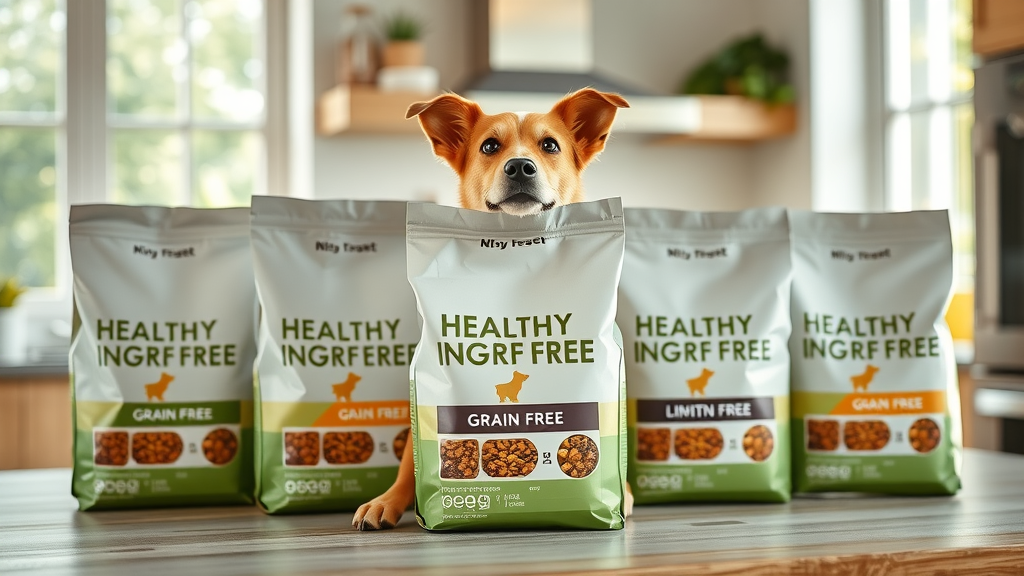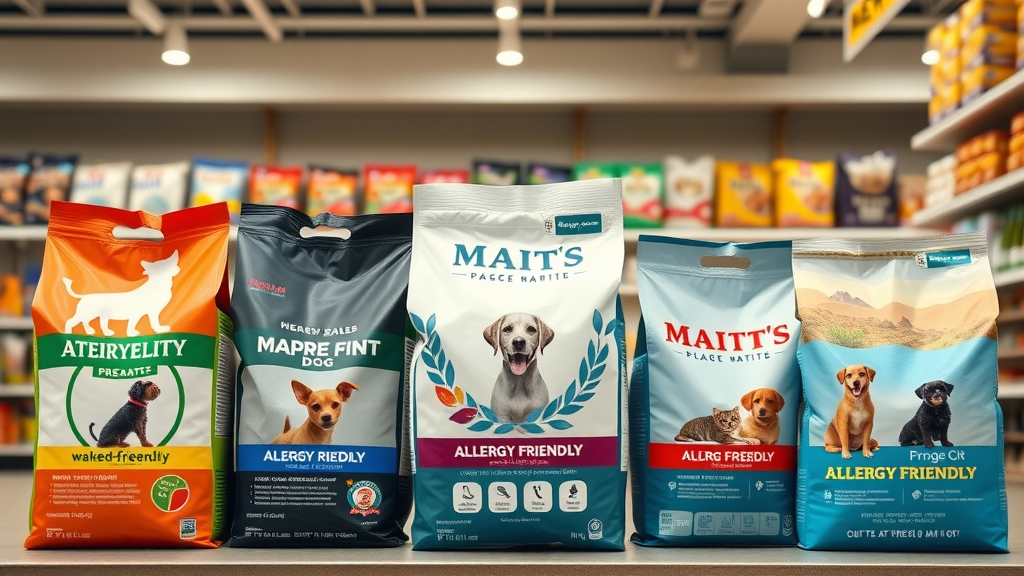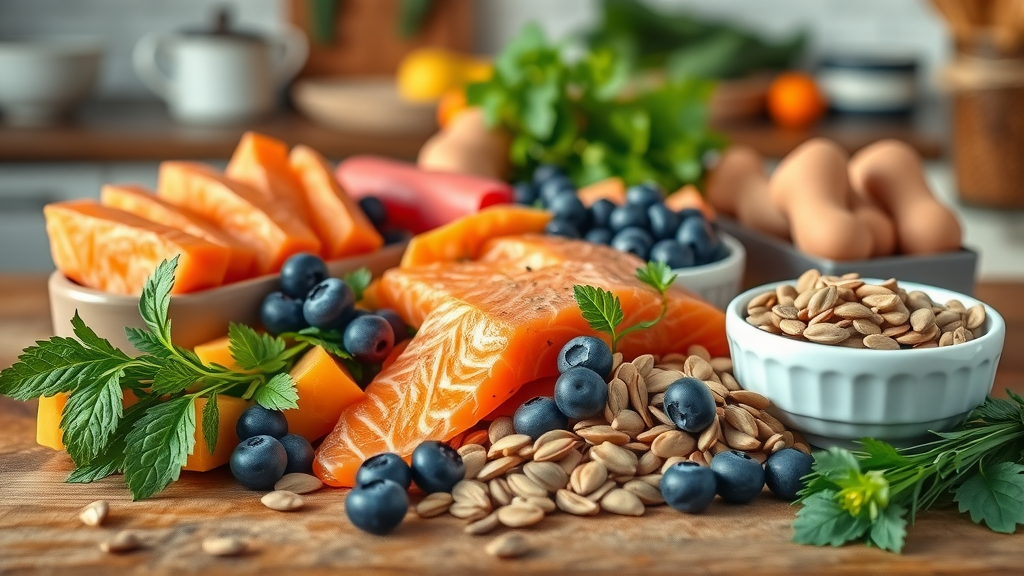Did you know up to 20% of all dogs experience some form of food allergy? For many pet parents, choosing the right dog food for allergies isn't just about keeping their dog well-fed—it's essential for their comfort and long-term health. If you've ever watched your dog struggle with itchy skin, upset stomachs, or chronic ear infections, you know how heart-wrenching it is to see your pet in distress. This comprehensive guide will walk you through everything you need to know, from recognizing allergy symptoms to choosing vet-recommended food for dogs with allergies, so your furry companion can thrive once more.
Why Choosing the Right Dog Food for Allergies Is Crucial for Your Dog's Health
"Studies show that up to 20% of all dogs suffer from some form of food allergy, making diet selection a pivotal part of canine wellness."

When you’re searching for the correct dog food for allergies , it’s more than a routine decision. A poorly matched diet can ignite a cascade of allergic reactions : itchy skin, persistent ear infections, and even serious gastrointestinal issues . Many commercial dog foods contain a variety of proteins and grains, making it hard to identify the source of a food allergy, and even harder for your dog to recover. Selecting targeted veterinary diets or limited ingredient dry dog food can be transformative, leading to visible improvements in energy levels and coat health. As awareness and diagnosis of food allergies in dogs become more common, every ingredient in your dog’s bowl matters more than you may realize.
Proactively addressing food allergies through the right dog food choices isn’t just about symptom relief—it directly impacts your dog’s long-term wellbeing. Chronic allergy symptoms can lead to secondary infections, decreased quality of life, and ongoing veterinary bills. By concentrating on allergy-friendly foods —from hydrolyzed protein formulas to novel protein sources —pet parents give their dogs the best chance to heal, play, and enjoy every mealtime free from discomfort.
Understanding Dog Food for Allergies: What Pet Owners Need to Know
- How to identify food allergies in dogs
- Types of dog foods formulated for allergies
- Ingredients to seek and avoid to reduce allergy symptoms
- The elimination diet process
- Leading brand options for dogs with allergies
Caring for dogs with food allergies starts with education. Not all dogs display classic allergy symptoms, making it crucial to understand what to look for—and how diet plays a role. Dog food for allergies falls into specialized categories: limited ingredient diets, prescription diet formulas, veterinary diets , and hydrolyzed protein products. These diets work by reducing exposure to known allergens, using unique protein sources, and avoiding troublesome fillers. Knowing what ingredients help or hinder allergic responses is central to supporting a dog with chronic issues. Eliminating trial and error saves both your dog’s comfort and your peace of mind.
The elimination diet is a gold standard for diagnosing food sensitivities . During this period, your dog consumes only novel protein and carbohydrate sources, helping identify the specific food triggers behind symptoms. Equipped with this knowledge and the right food for dogs with allergies , you'll unlock long-term relief for your pup. Many owners discover a world of new vetted brands ready to make mealtime safe and enjoyable again.
Recognizing Food Allergy Symptoms: Is Your Dog Suffering from Allergies?
- Itchy skin or excessive scratching
- Chronic ear infections
- Gastrointestinal upset (vomiting or diarrhea)
- Frequent paw licking or biting
- Red, inflamed skin

Many allergy symptoms overlap with signs of other health issues. However, if your dog frequently develops itchy skin , licks or bites their paws excessively, or battles recurrent ear infections , food could be the underlying culprit. Persistent gastrointestinal issues —including vomiting or diarrhea—may also point to a food allergy . These symptoms can develop gradually across weeks or months, causing ongoing discomfort for both dog and owner. Combined with visible skin redness or inflammation, these signs often trigger a search for alternative dog foods that avoid the usual problem ingredients.
Monitoring your dog's reactions after mealtime is critical. Track not only what your dog eats but also any table scraps or treats that could introduce unexpected ingredients. Keeping a health journal can help you identify the specific food that’s causing allergic reactions. Pet parents who act quickly can minimize long-term complications and improve their dog's quality of life, making proactive food choices and veterinary diet consultations invaluable for managing allergies.
Dog Food for Allergies: Identifying Food Allergies and Sensitivities in Dogs
Distinguishing Between Food Allergies and Food Sensitivities
Understanding the difference between food allergies and food sensitivities is crucial for effective management. Food allergies trigger the immune system, often leading to visible signs such as skin irritation, hives, or severe gastrointestinal distress. In contrast, food sensitivities usually provoke milder reactions—like intermittent stomach upset or subtle changes in skin or coat—without the full immune response. Both conditions require attention but might need different strategies for relief.
While true food allergies in dogs are less common than sensitivities, both can make your dog miserable. The right diagnosis informs your selection process: veterinary diets or prescription diet foods are typically recommended for allergies, whereas sensitivities may respond to milder dietary changes or limited ingredient dog foods. Consulting with your veterinarian to determine which condition affects your dog can streamline the solution and minimize unnecessary food trials.
Common Food Allergens in Dog Foods and the Impact on Dogs with Allergies
Dog foods contain a diverse array of protein sources and fillers, but a handful of ingredients are responsible for the majority of food-related allergic reactions. The top culprits are beef, dairy, chicken, and wheat. These proteins and grains are found in most commercial dry dog food formulations, increasing the risk of sensitivities developing over time. For dogs with allergies, repeated exposure to these ingredients often intensifies symptoms, making a switch to alternative diets imperative.
In severe cases, even minute amounts of a trigger food can prompt a major allergic reaction—underscoring the need for vigilance with every meal and treat. Identifying these common allergens, then switching to dog food for allergies featuring novel proteins and alternative grains, sets the stage for effective relief and a better quality of life. Consistency is key: avoid table scraps or random treats that could reintroduce allergens inadvertently.
| Allergen | Typical Food Sources | Allergy-Friendly Alternatives |
|---|---|---|
| Beef | Meat-based commercial diets | Duck, fish, venison |
| Dairy | Cheese, milk | Goat milk, lactose-free |
| Chicken | Chicken meals | Turkey, lamb |
| Wheat | Bakery treats | Sweet potato, rice |
Elimination Diets: Testing and Transitioning to New Dog Food for Allergies
- Remove all current food items
- Introduce novel protein and carbohydrate sources
- Observe dog's reaction for 8-12 weeks
- Slowly reintroduce other ingredients to identify triggers

The elimination diet is a powerful diagnostic tool recommended by veterinarians for suspected food allergies . This process requires strict removal of all potential allergens from your dog’s diet, replacing them with novel proteins and carbohydrates your dog hasn’t eaten before (such as duck and sweet potato). Over a period of 8 to 12 weeks, you'll monitor for improvement of allergy symptoms . Dramatic decreases in itching, skin redness, and gastrointestinal issues often confirm a food allergy diagnosis.
After this trial, other foods are systematically reintroduced one at a time. If symptoms return, you’ve identified the specific food causing the reaction. This careful, science-backed process minimizes guesswork, helping pet parents and veterinarians alike pinpoint the right dog food for dogs with allergies . Success rests on consistency—don’t allow even a single treat or table scrap outside the elimination diet protocol. Trust the process to reveal the foods your dog can safely eat, steering toward lifelong comfort.
Top Dog Food for Allergies: Best Veterinary Diets, Dry Dog Food, and Hydrolyzed Protein Formulas
Veterinary Diet and Prescription Diet Options for Dogs with Allergies
For moderate to severe food allergies , veterinarians frequently prescribe specialized diet options designed for safety and efficacy. Veterinary diets are formulated under strict standards, often using hydrolyzed proteins or single-source novel ingredients. These diets, such as Hill’s Prescription Diet or Royal Canin Veterinary Diet, can be life-changing for dogs with persistent allergies resistant to over-the-counter remedies. Regular check-ins with your veterinarian ensure the diet is working and that your dog receives all necessary nutrients—the cornerstones of allergy management.
Prescription diet varieties target both food and environmental allergen triggers through a combination of precise ingredient control and supplementation for immune support. They’re typically available by veterinary recommendation, making them a trustworthy solution for dogs whose dry dog food or commercial diets have failed.
Hydrolyzed Protein Diets: How They Aid Dogs with Food Allergies
"Hydrolyzed protein diets are scientifically shown to reduce allergic response in most diagnosed cases, making them a top recommendation by veterinarians."
In hydrolyzed protein diets, animal proteins are broken down into tiny, less recognizable pieces, reducing the chances of the immune system reacting. This unique dog food for allergies approach can provide dramatic relief for dogs with severe or complex food allergy issues—especially when other diets fail. Many veterinary diet products now feature hydrolyzed proteins for their proven track record in minimizing allergic reactions .
These diets are especially ideal during elimination diet or food trial periods when pet parents need to be sure their dog receives complete nutrition while excluding all potential triggers. They are usually available in both wet and dry dog food versions, addressing a range of dietary preferences and needs. With close veterinary monitoring, most dogs show significant improvement in allergy symptoms on hydrolyzed protein plans.
Evaluating Dry Dog Food for Allergies: Key Features and Ingredients
- Grain-free formula
- Single-source animal protein
- Limited ingredient list
- No artificial additives

When selecting dry dog food for a pup with allergies, focus on formulas that limit ingredient complexity. A short list of recognizable components helps minimize the risk of accidental food allergy flares. Look for products marketing a single animal protein source (like salmon or venison) and a digestible carbohydrate (like sweet potato or rice). For dogs with food allergies sensitive to grain, grain-free options can also reduce symptoms—though be mindful to select those that are nutritionally balanced and free from unnecessary fillers or additives.
Other features to prioritize include the absence of artificial dyes, preservatives, or flavorings—common offenders in dog food for allergies . Many reputable brands now list all protein and carbohydrate sources clearly and even indicate if their recipes are approved by organizations like the American Feed Control Officials . By evaluating ingredient transparency and quality, you equip your dog with safe, reliable nutrition and continuous allergy relief.
Best Brands of Dog Food for Allergies: Comprehensive Reviews and Top Picks
- Hill’s Prescription Diet
- Royal Canin Veterinary Diet
- Blue Buffalo Basics
- Natural Balance LID
- Purina Pro Plan Veterinary Diets

There’s no shortage of options for dog food for allergies —but trusted brands stand out for their longstanding safety and efficacy. Hill’s Prescription Diet and Royal Canin Veterinary Diet are cornerstone veterinary diets , offering targeted support for diagnosed allergies using both hydrolyzed and limited-ingredient formulas. Blue Buffalo Basics and Natural Balance LID (Limited Ingredient Diet) serve as over-the-counter alternatives, providing single-source protein recipes with minimal fillers. Purina Pro Plan Veterinary Diets bridges the gap with highly palatable, tightly controlled recipes developed in conjunction with veterinary nutritionists.
Each of these brands undergoes rigorous testing and continuous research, helping ensure that the dog food for allergies you choose is both safe and tailored to meet specific needs. Read reviews, consult your veterinarian for a recommendation based on your dog’s symptoms, and commit to a trial with the brand best suited for your situation. Successful allergy management often starts with brand quality and ingredient transparency.
Nutritional Support: Key Ingredients in Dog Foods for Allergies and Dogs with Sensitivities
| Ingredient | Benefit for Allergic Dogs |
|---|---|
| Omega-3 Fatty Acids | Reduces inflammation and itching |
| Novel Proteins | Minimizes exposure to known allergens |
| Prebiotics & Fiber | Supports digestive health |
| Antioxidants | Enhances immune function |

Beyond removing allergens, the best dog food for allergies aims to soothe the immune system and repair skin. Ingredients like omega-3 fatty acids (often from fish oils or flaxseed) can reduce persistent itching and inflammation in dogs with allergies . Novel protein sources—duck, fish, venison—minimize reactivity and allow your dog’s system to recover. Prebiotics and dietary fiber enhance gut health, supporting overall digestive resilience and helping prevent recurring gastrointestinal issues .
Antioxidants—derived from sources like blueberries, pumpkin, and leafy greens—remain vital for immune system support. These elements help counteract the effects of chronic allergies on your dog’s overall vitality. When reviewing dog foods for allergies , check labels carefully to confirm the inclusion of these supportive nutrients. Choosing foods with scientifically-backed supplement blends can elevate allergy management and restore healthy fur, skin, and energy levels, making allergy relief more comprehensive than ever before.
Transitioning Your Dog to Allergy-Friendly Dog Foods: Steps for Success
- Gradually mix new food with current diet
- Increase new food ratio over 7-10 days
- Watch for recurring allergy symptoms or GI distress
- Consult your veterinarian on progress

Shifting to a new dog food for allergies isn’t a process to rush. Begin by blending a small amount of the allergy-friendly food into your dog’s usual meal, increasing the proportion steadily over 7 to 10 days. This gradual transition minimizes digestive upset—a common risk for both food-sensitive and healthy dogs . Monitor closely for any return or escalation of allergy symptoms , such as itching, loose stool, or upset stomach.
Continuous observation is key to early detection of negative reactions or signs of improvement. Consult your veterinarian regularly throughout the process, adjusting the transition speed and ingredients as directed. Some dogs, especially those with chronic food sensitivities , need additional support or even a further adjustment in protein source or brand. By prioritizing a gradual transition, you foster better compliance and give your dog the greatest chance at relief and happy, symptom-free eating.
People Also Ask: What is the best food for dogs with allergies?
The best food for dogs with allergies contains limited ingredients, uses novel proteins, and is free from common allergens such as beef, dairy, chicken, and wheat. Veterinary and hydrolyzed protein formulas are often recommended by veterinarians for severe cases.
People Also Ask: What food is good for dogs with itchy skin?
Foods high in omega-3 fatty acids and with limited allergen exposure (like salmon, venison, sweet potato, and grain-free recipes) are typically good for managing itchy skin in dogs.
People Also Ask: How to tell if your dog is allergic to his food?
Signs your dog is allergic to food include chronic scratching, ear infections, vomiting, diarrhea, and skin redness after eating. An elimination diet is necessary for accurate diagnosis.
People Also Ask: What are the top 3 things dogs are allergic to?
The top three food allergens for dogs are beef, dairy, and chicken.
Video: How to Choose the Best Dog Food for Allergies (Step-by-Step Visual Guide)
Watch this easy guide to learn how to select, prepare, and measure the right allergy-friendly food for your dog, including interpreting ingredient labels and tips from veterinary nutritionists. (Insert educational video here.)
Consultation and Ongoing Management for Dogs with Allergies: When to See a Veterinarian

Persistent allergy symptoms or lack of improvement warrant prompt veterinary attention. Some dogs with food allergies require ongoing monitoring or additional testing to rule out environmental allergen triggers. Work closely with your veterinarian to determine when to adjust the diet, add supplements, or retest with different protein sources. Ongoing management includes routine checkups to ensure that the allergy-friendly dog food continues to support your dog’s evolving needs.
Establishing a partnership with your veterinary care team helps you address new or changing symptoms quickly, preventing more serious health issues. Timely intervention ensures your dog always benefits from the most up-to-date recommendations for dog food for allergies , minimizing discomfort and supporting long-term health.
Frequently Asked Questions About Dog Food for Allergies
- How long does allergy relief take after switching foods? Most dogs show noticeable improvement in 4 to 12 weeks, but severe cases may require longer and closer veterinary oversight.
- Can home-cooked diets help? Potentially yes, as long as recipes are carefully balanced and developed with veterinary input. Homemade diets allow total control over ingredients but must meet all of your dog’s nutritional needs.
- What are signs that a dog food is working for allergies? You should see reduced itching, clearer skin, improved stools, and less paw or ear irritation within several weeks of feeding an appropriate allergy formula.
Video: Success Stories – Real Dogs Who Found Relief with Dog Food for Allergies
"Switching to a prescription or hydrolyzed diet changed my dog's life – the itching disappeared, and her coat is now shinier than ever." — Pet Owner Testimonial
Experience firsthand transformations of dogs overcoming severe food allergy symptoms by switching their diets—watch hopeful and inspiring testimonials in this video guide. (Insert real-life video stories here.)
Final Thoughts: Helping Your Dog Thrive with the Right Dog Food for Allergies
Take action today—work with your veterinarian to select high-quality, allergy-friendly dog food for allergies and restore your best friend’s health, happiness, and playful spirit.
Take Action: Start Your Dog’s Allergy-Free Journey with Expert-Recommended Dog Food for Allergies Today
Don’t wait—every meal counts for dogs with allergies . Choose a proven, veterinarian-recommended food for dogs with allergies and support your pet’s comfort and vitality. Your dog’s relief can start with your next order—commit to their wellbeing today!
When managing your dog’s food allergies, selecting the right diet is essential for their health and comfort. Here are some top-rated options:
1. Purina Pro Plan Veterinary Diets HA Hydrolyzed Formula Dog Food
This diet features hydrolyzed proteins, which are broken down into smaller components to minimize allergic reactions. It’s suitable for dogs of all sizes and is known for its digestibility. ( rd.com )
2. Royal Canin Veterinary Diet Hydrolyzed Protein Canned Dog Food
Formulated with hydrolyzed proteins, this wet food is designed for dogs with food sensitivities. It supports skin health and is highly palatable, making it ideal for picky eaters. ( rd.com )
3. Wellness Simple Limited Ingredient Diet Lamb & Oatmeal
This limited-ingredient diet uses lamb as a single protein source and includes easily digestible carbohydrates like oatmeal. It’s free from fillers and additives, making it a budget-friendly option for dogs with allergies. ( rd.com )
4. Merrick Limited Ingredient Diet Grain-Free Dry Dog Food
Featuring deboned lamb as the primary protein and sweet potatoes as the main carbohydrate, this grain-free formula is designed for dogs with food sensitivities. It also includes omega fatty acids to promote healthy skin and coat. ( furryfolly.com )
5. Natural Balance L.I.D. Limited Ingredient Diets Salmon & Brown Rice Formula
This diet offers a simple recipe with premium ingredients, including real salmon and brown rice, to provide essential vitamins and minerals. It’s designed to minimize the risk of food sensitivities. ( thedodo.com )
Consulting with your veterinarian is crucial before making dietary changes to ensure the chosen food aligns with your dog’s specific needs.
 Add Row
Add Row  Add
Add 








Write A Comment